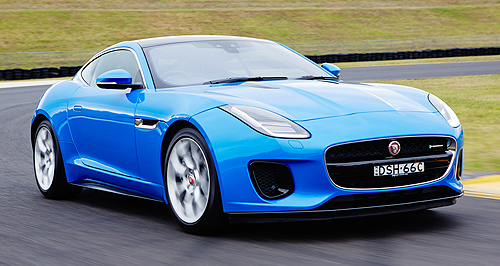Future models - Jaguar - J-TypeJaguar covers electric bases with J-TypeCharged: Jaguar is yet to confirm its intention for the J-Type badge, but British reports suggest a vehicle with this moniker will replace the F-Type and potentially come with hybrid and full-electric powertrains. Electric, hybrid and autonomous tech covered in Jaguar’s J-Type trademark12 Sep 2018 JAGUAR’S application for a renewed J-Type global trademark provides the biggest hint yet that it is considering electrification for a future supercar, with the submission containing references to electric and hybrid vehicles and related technologies, including charging equipment and autonomous driving systems.
The British marque has owned the J-Type trademark since 2002, presumably to protect the badge for a potential future model.
Although the current registration for J Type – without the hyphen – does not lapse until October 2021, the company’s trademark attorneys lodged a fresh global application in July for J-Type – with the hyphen – and extended cover that now includes a broad range of electronics, electrical devices and services for vehicles, including charging stations.
British media reports speculate the J-Type will replace the F-Type sports coupe about 2022, this time possibly switching to a mid-engine hybrid layout at launch and perhaps following up with a full-electric version.
Auto Express reports that the mechanical make-up of the car is still being finalised, but that it could be expected to have electric motors on the front and rear axles to provide all-wheel drive, I-Pace style.
Instead of an engine in the front like the F-Type, Auto Express says the new model is likely to have a V6 mounted in the middle, supplemented by the electric motors.
It says the powertrain would need at least 410kW of power to be competitive against the likes of the McLaren 570S.
If it eventuates, a mid-engine J-Type would be only the second Jaguar mass-produced in this configuration, following on from the XJ220 supercar of the 1990s.
A move to electrification in its new sportscar line is unsurprising, as Jaguar has been pursuing this route through all of its models in recent years.
Jaguar design director Ian Callum told GoAuto at last year’s Frankfurt motor show that he had probably designed his last full IC (internal combustion) vehicle.
The F-Type performance champion is the supercharged 5.0-litre V8 SVR that bangs out 423kW and 700Nm, which is sufficient to push the coupe version from zero to 100km/h in 3.7 seconds.
However, that beefy performance comes with a fuel penalty, with the SVR chewing through more than 11 litres of petrol per 100km.
The most powerful V6 version of the F-Type is the supercharged 3.0-litre 400 with 294kW and 460Nm
In Australia, the F-Type comes in an extraordinary 32 variants, including coupe and convertible body styles with four-, six- and eight-cylinder powertrains with a choice of six-speed manual and eight-speed automatic transmissions driving the rear wheels or all four wheels.
Launched in 2014, the F-Type has been a steady if not spectacular performer in the sportscar segment above $80,000, peaking at 186 sales in 2016.
So far this year, it has achieved 67 sales – down 22.1 per cent on the first eight months of last year.
When car manufacturers apply for trademark registration for a new model, they usually list the application under Class 12, which applies to all types of land transport vehicles, including those with internal combustion engines.
In its J-Type application, however, Jaguar Land Rover has broadened that to include Class 9 – covering a wide range of specific electronics and electrical devices – and Class 37 – covering services for vehicles.
Listed among the hundreds of items in the Class 9 application are technologies for autonomous driving and “charging stations for charging electric vehicles; apparatus and cables for use in charging electric vehicles; batteries for vehicles”.
Charging station services for electric vehicles and vehicle battery charging are also covered in the Class 37 fine print.
In Australia, the application is listed as “being considered”, with a report to be issued on January 9, 2019.
Jaguar Australia will launch its first all-electric vehicle, the I-Pace SUV, in Australia in November.
A 90kWh lithium-ion battery powers two electric motors with a combined output of 294kW and 696Nm and a driving range of up to 480km.  Read more22nd of August 2018  Jaguar to offer five-year warranty on I-Pace SUVFive-year/200,000km warranty for I-Pace EV resets Jaguar standardAll future models Alfa Romeo Alfa Romeo Abarth Abarth Audi Audi Aston Martin Aston Martin BMW BMW Bentley Bentley Chrysler Chrysler Chevrolet Chevrolet Dodge Dodge Citroen Citroen Ferrari Ferrari DS DS Ford Ford Fiat Fiat FPV FPV Foton Foton Haval Haval Great Wall Great Wall Honda Honda Holden Holden Hyundai Hyundai HSV HSV Isuzu Isuzu Infiniti Infiniti Jeep Jeep Jaguar Jaguar Lamborghini Lamborghini Kia Kia Lexus Lexus Land Rover Land Rover Mazda Mazda Maserati Maserati Mercedes-Benz Mercedes-Benz McLaren McLaren Mini Mini Nissan Nissan Mitsubishi Mitsubishi Peugeot Peugeot Opel Opel Proton Proton Porsche Porsche Renault Renault Ram Ram Saab Saab Rolls-Royce Rolls-Royce Smart Smart Skoda Skoda Subaru Subaru SsangYong SsangYong Tesla Tesla Suzuki Suzuki Toyota Toyota Volvo VolvoMotor industry news |
Click to shareJaguar modelsResearch Jaguar All future models Alfa Romeo Alfa Romeo Abarth Abarth Audi Audi Aston Martin Aston Martin BMW BMW Bentley Bentley Chrysler Chrysler Chevrolet Chevrolet Dodge Dodge Citroen Citroen Ferrari Ferrari DS DS Ford Ford Fiat Fiat FPV FPV Foton Foton Haval Haval Great Wall Great Wall Honda Honda Holden Holden Hyundai Hyundai HSV HSV Isuzu Isuzu Infiniti Infiniti Jeep Jeep Jaguar Jaguar Lamborghini Lamborghini Kia Kia Lexus Lexus Land Rover Land Rover Mazda Mazda Maserati Maserati Mercedes-Benz Mercedes-Benz McLaren McLaren Mini Mini Nissan Nissan Mitsubishi Mitsubishi Peugeot Peugeot Opel Opel Proton Proton Porsche Porsche Renault Renault Ram Ram Saab Saab Rolls-Royce Rolls-Royce Smart Smart Skoda Skoda Subaru Subaru SsangYong SsangYong Tesla Tesla Suzuki Suzuki Toyota Toyota Volvo VolvoMotor industry news |
















Facebook Twitter Instagram